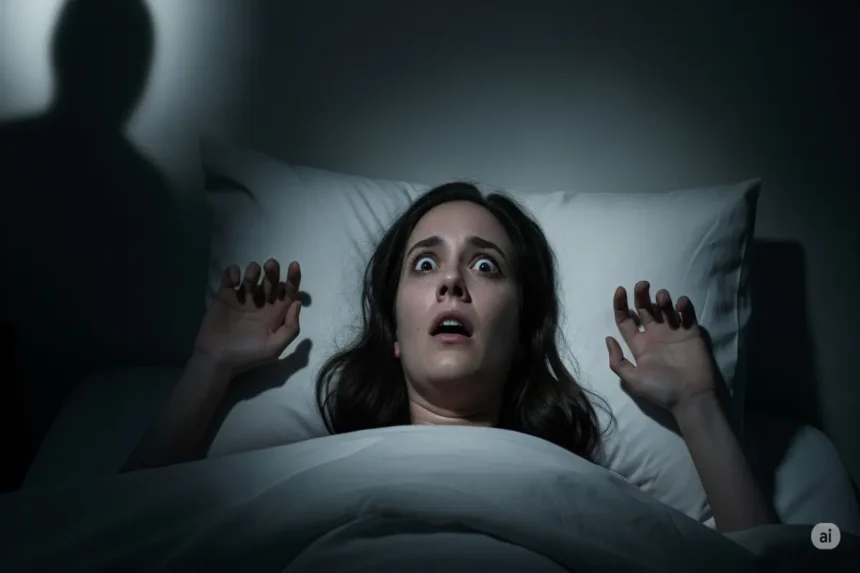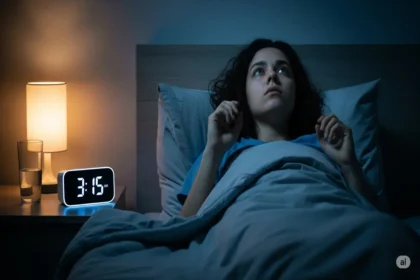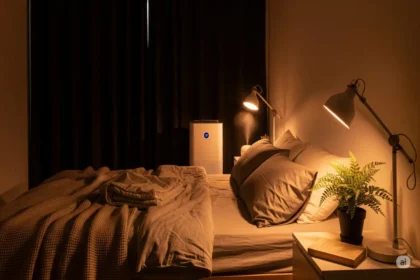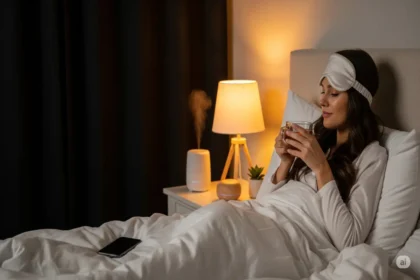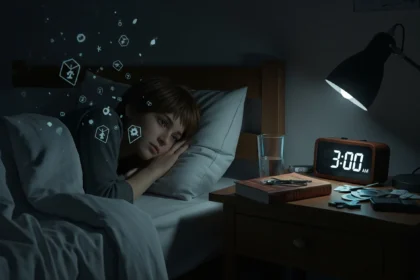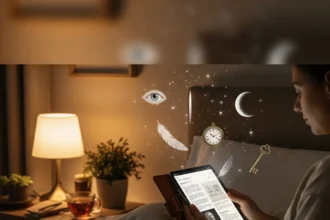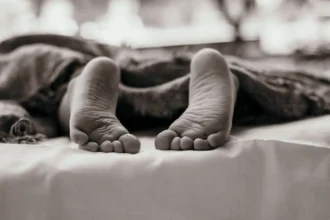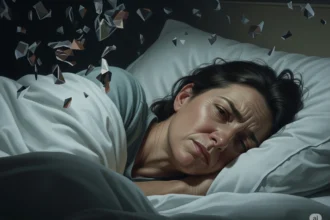The transition from the waking world to the realm of dreams is usually seamless, a gentle drift into unconsciousness. But for millions, this boundary can become a terrifying trap. Imagine waking up, fully aware of your surroundings, perhaps even hearing familiar sounds or seeing your bedroom, yet being utterly unable to move a single muscle, speak a word, or even cry out for help. This chilling experience, often accompanied by a crushing sensation on the chest or the vivid hallucination of a shadowy presence, is known as Sleep Paralysis. It’s a phenomenon that has haunted humanity for centuries, inspiring folklore, fueling supernatural tales, and leaving those who experience it feeling vulnerable and deeply unnerved.
Consider Maria, a young professional who, after a few nights of disrupted sleep due to a demanding project, suddenly found herself “awake” but frozen in her bed. She could see her alarm clock, hear the distant hum of traffic, but her body was unresponsive. A heavy weight pressed on her chest, and she felt an unseen presence in the room, a terrifying sensation that lasted what felt like an eternity before she could finally gasp for air and move. Maria’s experience is not unique; it’s a classic encounter with sleep paralysis, a temporary glitch in the brain’s intricate sleep-wake cycle that, while often frightening, is rooted in fascinating neurobiology. Understanding this phenomenon can transform it from a terrifying ordeal into a manageable, albeit still unsettling, experience.
What is Sleep Paralysis? The Science of Being ‘Stuck’
At its core, sleep paralysis is a temporary state of being unable to move or speak that occurs when you are either falling asleep (hypnagogic or pre-dormital sleep paralysis) or waking up (hypnopompic or post-dormital sleep paralysis). During these episodes, your mind is conscious and alert, but your body remains in a state of atonia – the natural muscle paralysis that occurs during Rapid Eye Movement (REM) sleep.
To understand why this happens, we need to look at the normal sleep cycle. Our sleep is divided into several stages, cycling between Non-Rapid Eye Movement (NREM) and REM sleep. REM sleep is the stage where most vivid dreaming occurs. During REM, the brain sends signals to the spinal cord that effectively “turn off” the motor neurons, paralyzing the voluntary muscles. This is a crucial protective mechanism, preventing us from physically acting out our dreams and potentially injuring ourselves or others.
Sleep paralysis occurs when there’s a disconnect in this carefully orchestrated process. Your brain “wakes up” – meaning your consciousness returns – but the atonia from REM sleep hasn’t fully disengaged. You are, quite literally, stuck between wakefulness and sleep, your mind active but your body still in its dream-state paralysis. This can last from a few seconds to several minutes, and while it feels like an eternity, it is not life-threatening. You can still breathe, as the diaphragm and other involuntary muscles are not affected.
The Hallucinatory Companions: Visions in the Void
What often elevates sleep paralysis from merely unsettling to truly terrifying are the vivid, often bizarre, hallucinations that can accompany it. These are known as hypnagogic (at sleep onset) or hypnopompic (at awakening) hallucinations, and they are distinct from dreams. They feel incredibly real, blending seamlessly with your actual surroundings.
These hallucinations typically fall into three categories:
- Intruder Hallucinations: This is perhaps the most common and frightening. Individuals report sensing a threatening presence in the room, seeing shadowy figures, or even feeling someone standing over them or sitting on their chest. This often leads to feelings of intense fear, dread, and paranoia.
- Incubus Hallucinations: Closely related to intruder hallucinations, these involve a feeling of pressure on the chest or difficulty breathing, as if someone or something is weighing down on them. This sensation can heighten the sense of suffocation and panic.
- Vestibular-Motor Hallucinations: These involve sensations of movement, such as floating, flying, falling, or an out-of-body experience. While less overtly terrifying, they can still be disorienting and unsettling.
Why do these hallucinations occur? During sleep paralysis, your brain is in a heightened state of arousal and hyper-vigilance, but it’s not receiving normal sensory input from your body (because of the paralysis) or from the external world (because your eyes might be closed or your brain is still in a dream-like state). In an attempt to make sense of this confusing and threatening situation, the brain essentially “fills in the blanks” with internal imagery and fear-driven projections. The amygdala, the brain’s fear center, is highly active during REM sleep and can remain so during sleep paralysis, contributing to the intense feelings of dread and the perception of a threat. The feeling of chest pressure might stem from the brain misinterpreting the natural effort of breathing against the relaxed muscles of the chest wall.
Cultural Interpretations: Ancient Fears, Modern Explanations
For centuries, before scientific understanding, cultures around the world developed rich and often terrifying folklore to explain sleep paralysis. These narratives, passed down through generations, highlight the universal nature of the experience and humanity’s innate need to make sense of the unknown.
- The Night Hag: In many Western cultures, particularly in English folklore, sleep paralysis was attributed to a malevolent entity known as a “night hag” or “old hag” who would sit on the sleeper’s chest, causing the sensation of pressure and difficulty breathing. Henry Fuseli’s famous 1781 painting, “The Nightmare,” vividly depicts this terrifying figure.
- Demons and Evil Spirits: Across various cultures, including parts of Africa, the Middle East, and Europe, sleep paralysis was often seen as an attack by demons, evil spirits, or jinn (genies). The feeling of being held down or suffocated was interpreted as the entity’s physical presence.
- Alien Abduction: In modern times, particularly since the mid-20th century, some individuals interpret sleep paralysis experiences, especially those involving shadowy figures or sensations of being lifted, as encounters with extraterrestrial beings or alien abductions.
- Kanashibari (Japan): In Japan, sleep paralysis is known as kanashibari, meaning “bound by metal” or “tied up.” It’s often associated with supernatural forces, sometimes linked to Buddhist beliefs or vengeful spirits.
- Mara (Slavic/Norse): In Slavic and Norse mythology, the “Mara” is a malevolent being that sits on people’s chests, causing nightmares and sleep paralysis. The word “nightmare” itself is derived from “mara.”
- Old Hag (Newfoundland): In Newfoundland, Canada, the “Old Hag” is a prominent figure in local folklore, a witch-like entity believed to cause sleep paralysis.
These cultural interpretations, while varying in their specific entities, share a common thread: they provide an external explanation for an internal, terrifying experience, offering a narrative framework for something that feels utterly beyond the dreamer’s control.
Who Experiences It and Why? Common Triggers
Sleep paralysis is surprisingly common, with studies suggesting that between 5% and 8% of the general population experience it regularly, and up to 70% may experience it at least once in their lifetime. While it can affect anyone, certain factors increase the likelihood of experiencing it:
- Sleep Deprivation: This is perhaps the most significant trigger. Not getting enough sleep, or having very fragmented sleep, destabilizes the sleep-wake cycle, making it more prone to glitches.
- Irregular Sleep Schedules: Shift work, jet lag, or inconsistent bedtimes can disrupt the body’s natural circadian rhythm, increasing the risk.
- Stress and Anxiety: High levels of psychological stress, anxiety disorders, or trauma can contribute to sleep paralysis episodes. The brain’s heightened state of arousal can make it more difficult to smoothly transition between sleep stages.
- Sleeping on Your Back: While not a direct cause, sleeping supine (on your back) has been anecdotally and sometimes scientifically linked to a higher incidence of sleep paralysis, possibly due to increased airway obstruction or pressure on the chest.
- Genetics: There appears to be a genetic predisposition to sleep paralysis, with some individuals having a family history of the condition.
- Substance Use: Alcohol, nicotine, and certain medications (especially those affecting neurotransmitters) can disrupt sleep architecture and increase the risk.
- Underlying Sleep Disorders: Sleep paralysis can be a symptom of other sleep disorders, most notably narcolepsy. If sleep paralysis is accompanied by excessive daytime sleepiness, sudden muscle weakness (cataplexy), or other REM-related symptoms, narcolepsy should be considered.
Coping and Management: Reclaiming Your Nights
While sleep paralysis can be frightening, understanding its benign nature is the first and most crucial step in managing it. Here are scientifically-backed strategies:
- Improve Sleep Hygiene: This is the cornerstone of prevention.
- Consistent Sleep Schedule: Go to bed and wake up at the same time every day, even on weekends, to regulate your circadian rhythm.
- Adequate Sleep: Aim for 7-9 hours of quality sleep per night.
- Relaxing Bedtime Routine: Wind down for 30-60 minutes before bed with activities like reading, a warm bath, or meditation.
- Optimize Sleep Environment: Ensure your bedroom is dark, quiet, and cool.
- Avoid Stimulants/Alcohol: Limit caffeine and alcohol, especially in the hours before bed.
- Manage Stress and Anxiety: Incorporate stress-reduction techniques into your daily life, such as mindfulness, yoga, deep breathing exercises, or therapy. Reducing overall anxiety can significantly decrease the frequency of episodes.
- Change Sleep Position: If you frequently experience sleep paralysis while sleeping on your back, try sleeping on your side. Using a body pillow or a “tennis ball trick” (sewing a tennis ball into the back of your pajama top) can help prevent you from rolling onto your back.
- During an Episode: Stay Calm and Focus on Small Movements:
- Recognize It: Remind yourself that it’s sleep paralysis, it’s temporary, and it’s harmless. This cognitive reframing can reduce panic.
- Resist Panic: Panicking often intensifies the fear and hallucinations.
- Focus on Wiggling a Digit: Instead of trying to move your whole body, concentrate all your effort on wiggling a finger or a toe. This small, deliberate movement can sometimes “break” the paralysis.
- Try to Cough or Make a Sound: While difficult, some people find success by trying to make a small sound or cough, which can sometimes trigger a full awakening.
- Avoid Opening Your Eyes (if terrifying hallucinations): If the visual hallucinations are particularly frightening, keeping your eyes closed might reduce the distress.
- Seek Professional Help: If sleep paralysis episodes are frequent, highly distressing, or accompanied by excessive daytime sleepiness or other unusual symptoms, consult a doctor or a sleep specialist. They can rule out underlying sleep disorders like narcolepsy or provide further guidance and, in rare cases, prescribe medication.
Conclusion: Demystifying the Night’s Embrace
Sleep paralysis, with its terrifying blend of consciousness and immobility, has long been a source of fear and supernatural speculation. Yet, modern science has pulled back the curtain on this enigmatic phenomenon, revealing it as a fascinating, albeit unsettling, glitch in the brain’s sleep-wake machinery. Understanding that it is a benign, temporary state, and learning effective coping strategies, can empower individuals to reclaim their nights from the grip of fear.
The experience serves as a powerful reminder of the extraordinary complexity of our brains, constantly dancing on the edge of consciousness, even in the depths of slumber. By demystifying sleep paralysis, we not only alleviate personal distress but also deepen our appreciation for the intricate, sometimes bizarre, wonders of the human mind. So, the next time the night’s embrace feels too tight, remember the science, stay calm, and know that you are not alone in this peculiar journey between worlds.
Disclaimer: The information provided in this article is for general informational purposes only and does not constitute medical advice. It is not a substitute for professional medical advice, diagnosis, or treatment. Always seek the advice of your physician or other qualified health provider with any questions you may have regarding a medical condition. Never disregard professional medical advice or delay in seeking it because of something you have read on this website.

